Nose to tail isn’t a passing fad in Nigeria, or a new culinary trend – it has and always will be a part of our food culture, of our heritage. It isn’t the offspring of one parent – poverty, but it was born of necessity, of sustainability, of wasting not and thus wanting not. It is embroidered in our cuisine and our history.
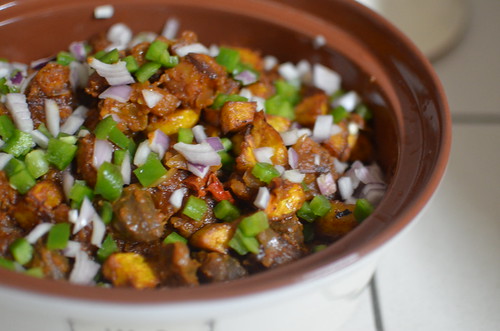
Unusual ‘meats’ are not occasional guests at the table, reserved for private showings. No way, they live, breathe and feature in the daily drama that is life in Nigeria. In fact, daily life is a small thing, parties and events are where offal, innards and other less-popular meat parts shine!
Take that 50th birthday party. The first bowls to depart the kitchen and arrive steaming hot and aromatic onto the tables of guests is likely to be peppersoup. The finest sort is filled with bite-sized pieces of goat meat and offal – tripe, intestines, liver, kidney. And this is not something reserved for poor neighbours – quite the opposite.
Before the meats are cooked, care is taken to ensure they are properly cleaned. The tripe that exits a cow’s belly green is given a hot soak, after which it is ‘scraped’ before it enters the world of the cooking pot, creamy-white and clean. Yes, you can find it already cleaned at some open-air markets but since the buyers aren’t sure what kind of water was used to clean it, they are content to spend an extra half hour at home prepping it. Here intestines of any sort are not confined to ‘sausage casing’ terroir. Far from it, they are turned inside out, cleaned and prepared for the eating.
Oxtail. Cow foot. Goat head. These are all delicacies that we love and rever. Mostly. The dishes these unconventional food parts make their way into are varied: Peppersoup. Soups. Stews. Ogbono. Vegetables. But I find them most delicious in peppery, tomato-based sauces (stews, as we Nigerian’s know ’em).
Like this stewed gizzards and fried plantain (Dodo) dish, served as a small chop, an hor d’oeuvre, the apparently essential marriage of two separate dishes. Joined in holy matrimony once cooked by tossing together. To live happily thereafter.
A few days before a potluck, a friend and I are talking about the dishes I plan to bring along. She asks if there will there be yummy stuff and I assure her there will be but she wants more details. Finally, she suggests the ‘fried gizzard and dodo’ dish, assuming I know it. Which I don’t. Isi-ewu (Goat’s head sauce) – I know; peppered snails – I know but giz-do? I’m not at all familiar with, as a unique combination. I assure her I will work on the recipe and deliver.
One friend N, says when I ask her if she’s heard of giz-do, ‘Oh, I’ve had it at a party in Houston’. The other, B, who just moved back to Nigeria from Houston says ‘Yes, I know it, they serve it at all the Nigerian parties in Houston’.
Perhaps this is one dish that is more popular abroad than at home? Or maybe it is I who haven’t been a guest at the better parties where this is served? Who knows.
As I have big bags of chicken gizzards in my deep freezer, the matter is settled. Growing up I loved gizzards and in our house, there was always a fight to see who would get the one gizzard amidst the multitude of chicken parts.
Quote from All Nigerian recipes.com: When I was very young, I was made to believe that women and children would get sick if they ate gizzards. This is because this part of the chicken, referred to as nze-nze in Igbo is so revered where I come from that only the heads of families (the men) are supposed to eat it.I like the texture of gizzards, not soft but crunchy, cooked but with bite. According to Serious Eats, Fried gizzard lovers fall into two camps: those who want melt-in-your mouth gizzards and the others, like me – who want bite, who want to enjoy the peculiar texture gizzards have. Not quite beef, not quite kidney, more like tongue but wholly delicious. If cooked right, of course.
I am thrilled when I watch Guy Fieri on Triple D visit Joe’s Gizzard city, in Potterville, Michigan – the only gizzard city in the world. At Joe’s, gizzards sport a delicious, crispy coating. Another dimension to a dish that I will try some day.
The Anatomy of a Gizzard
Gizzards are commonly sold already prepared, and in Nigeria both Turkey and Chicken gizzards are common. The pouch, really the digestive tract of a chicken is used to grind up the foods the bird eats. The grinding and milling is done within ‘rubber’ walls of the gizzard which is filled with stones – the stones aid in the grinding of food.
Quote from Wisegeek.com: Gizzards are secondary stomachs used by birds to grind their food before digestion. Because birds don’t have teeth, they must fill this stomach with small stones to achieve the same goal. The organ contains a very tough inner membrane, surrounded by a muscular pouch which provides the grinding action. Gizzards are part of the group of foods called offal, which also includes beef tripe, chitlins (pork intestines), and hearts.
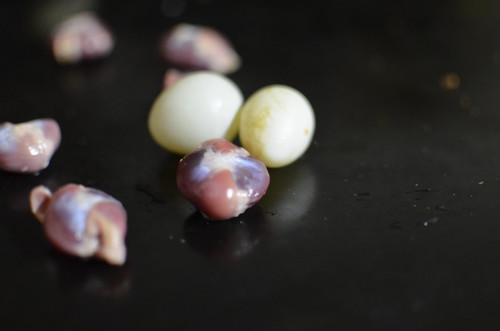
To prepare it for eating, the pouch which resembles a giant (weird) double-headed bean is split open and the contents of the stomach which may include food, stones and grass are removed.
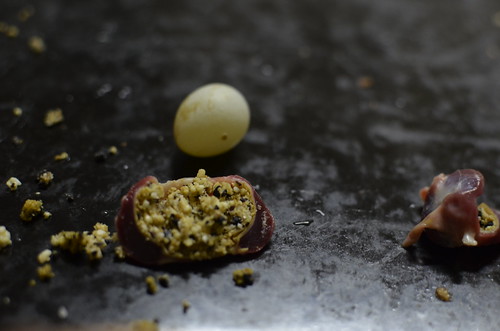
The ‘rubbery’ lining, which prevents the food from coming into contact with the gizzard flesh is removed…
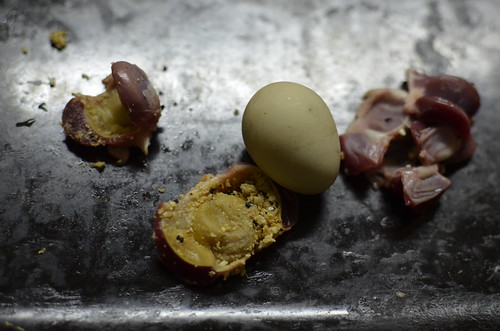
……by tugging!
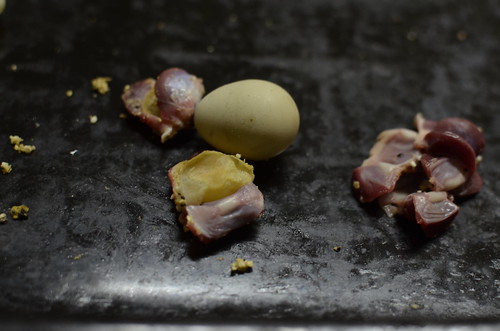
(Back to our regular viewing of a chicken gizzard)
You end up with a cleaned gizzard which can be used in a recipe.
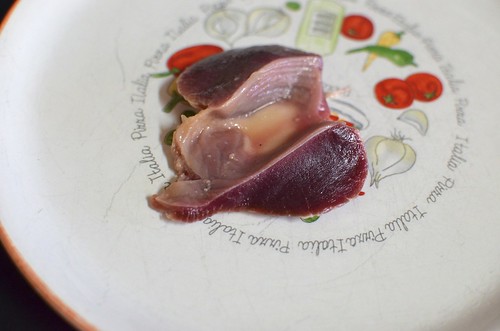
Gizzards – Dodo recipe
Ingredients
Cooked gizzards 1 kg cleaned gizzards (about 15 large chicken gizzards) 2 medium red onions, sliced A mix of chilli peppers, cut up – 1 yellow, 1 green and 1 red 1 teaspoon curry powder 1 teaspoon dried thyme 1 teaspoon ginger powder 1 teaspoon garlic powder Tomato stew 8 medium plum tomatoes, roughly chopped 3 medium red onions – 1 sliced & 2 roughly chopped for blending A mix of chilli peppers, cut up- 2 yellow, 1 green and 1 red 1 teaspoon curry powder 1 teaspoon dried thyme 1 teaspoon ginger powder 1 teaspoon garlic powder 1/4 – 1/2 cup Vegetable Oil Fried Plantains 6 ripe plantains Vegetable oil for deep-frying Salt, chilli powder, ginger powder – to taste Garnish Chopped green bell peppers Chopped onionPreparation
Cook the gizzards
Tip: I like to cut up my gizzards into smaller parts, typically into 3-4 pieces per gizzard so the resulting dish is bite-sized and perfect for an appetizer.
Into a medium saucepan, put the gizzards with the sliced onions, chopped chilli peppers, curry powder, dried thyme, ginger and garlic powders. Season with salt and top up with 2 cups of water, at room temperature.
Bring to the boil, and then turn down to simmer for half an hour, till the gizzards are cooked but still crunchy. They will cook a bit more in the stew as well. Once cooked, separate meat and sauce, keeping both.
Make the stew
Tip: Watch the seasoning, being careful not to over salt till the stewed gizzards are ready, as they don’t absorb a lot of the seasoning and can easily become over-salted and abrasive.
While the gizzards are cooking, prepare to make the ‘stew’. In a blender, combine the chopped tomatoes, onions and chilli peppers. Pulse for 5 seconds, 2 -3 times. You want a chunky sauce – bits of onions, tomatoes and chilies should still be visible.
Heat up a saucepan with 1/4 cup ( – 1/2 cup) of vegetable oil and fry the sliced onions, with a pinch of salt, about 5 minutes. Then add the pulsed tomato mixture and cook on medium to high heat for 10 minutes. You want the sauce to ‘fry’, so the liquid evaporates and you end up with a chunky, fried tomato sauce.
Combine the fried tomato sauce with the cooked gizzards on medium heat, loosening a bit with the gizzard ‘stock‘ from the cooking. Let simmer for about 5 minutes, so the gizzards can take on some of the spiced tomato flavour.
Make the Dodo
Set a deep fryer to 165 degrees centigrade.
Wash and dry 6 ripe plantains. The skins should be yellow with black spots and if pressed, the plantains should give.
Slice each plantain along the length then peel off the skin.
To dice the plantains, make a cross at one end and take the slices down, so the plantain is split into four, lengthways. Then slice into small dice across the width. Repeat for the other plantains.
Put the plantain dice in a large bowl and sprinkle salt, chilli powder and ginger flakes. Toss to coat the diced plantians with the seasoning.
Combine, to form Giz-Do
- Toss fried plantains, dodo with the warm, stewed gizzards.
- Garnish with chopped green bell peppers and diced onions.
- Serve on its own as a small chop, starter, hor d’oeuvre; or as part of main meal with rice or any other grain of your choice.
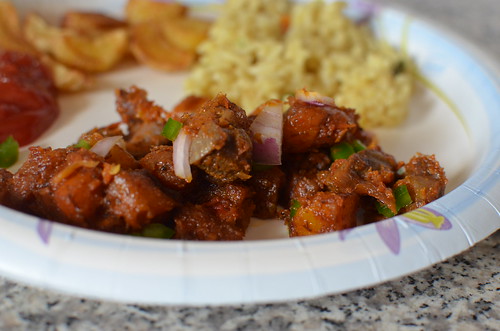
So tell me, what’s your take on nose-to-tail? Do you avoid offal? What are your gizzard experiences, if any? Tell me all!!!


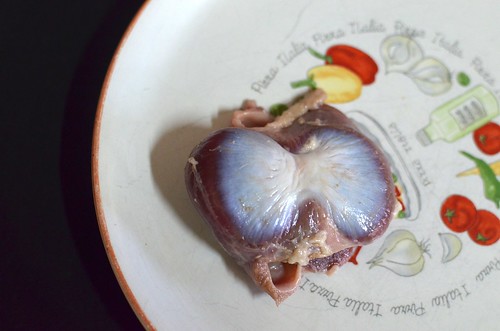
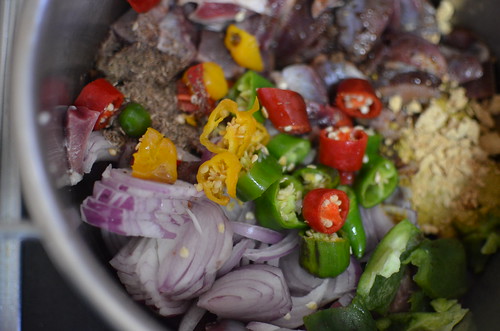
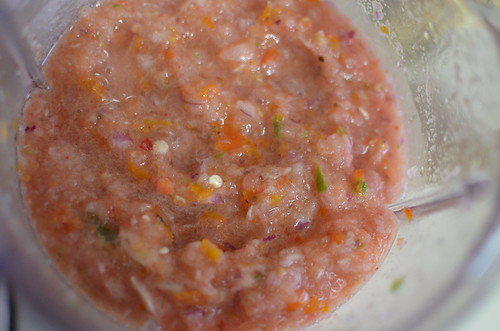
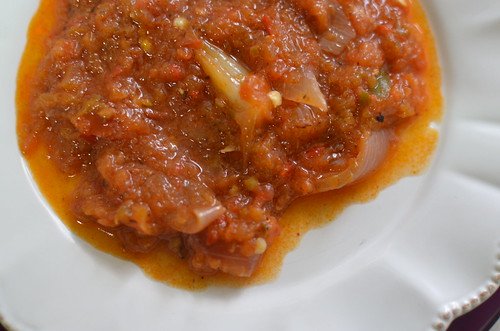
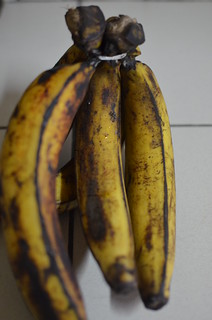

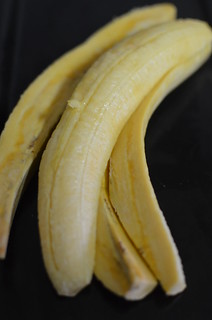
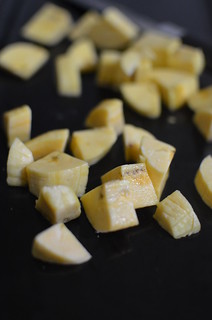
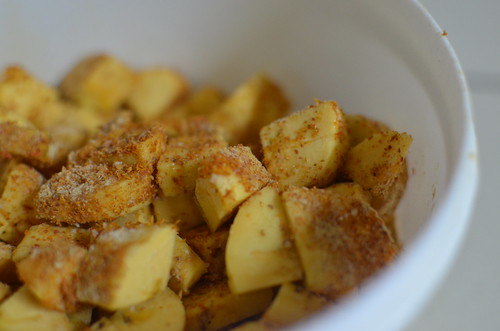
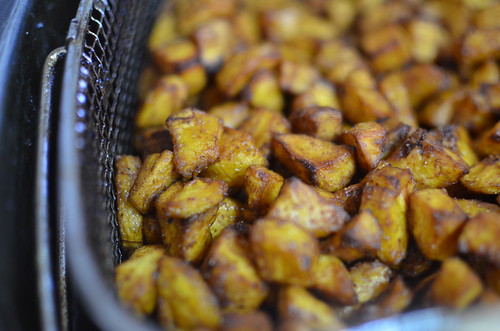
Leave a Reply